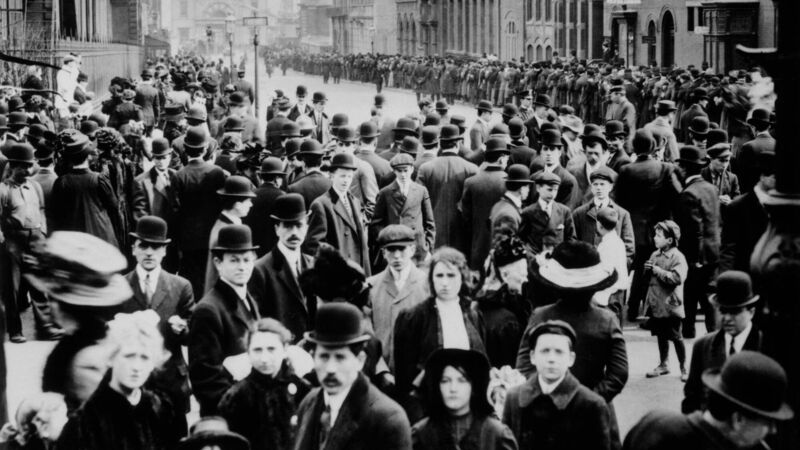Terry Prone: New York 1911 Triangle fire bore Stardust similarities

Crowds waiting to enter a morgue on 26th Street, New York City, to identify bodies of victims of the 1911 Triangle Shirtwaist fire. Picture: Getty
It happened 70 years before the Stardust tragedy, and at first glance doesn’t seem to have that much in common with that horror.
It was a fire in Manhattan’s garment district in 1911.
The sepia pictures show water being directed into the second-floor windows of a nine-storey building although the sheen on the ground outside the building suggests most of that water fell short.
Behind the puff of water is another New York Fire Department vehicle, this one housing a ladder that reaches the fourth floor. No higher. That was one reason for the high death toll: The ladders couldn’t reach the top floor, where the fire originated in the Triangle Shirtwaist factory.
New York, then as now, was a fashion centre, and what fashionistas of the time wanted were “shirtwaist” dresses and blouses.
Charles Dana Gibson, an illustrator created the “Gibson Girl”, who evoked the era, with writer Sinclair Lewis claiming she was “the Helen of Troy and Cleopatra of her day”.
The Gibson Girl featured on the cover of Scribner’s Magazine, cycling confidently towards the reader in a crisp shirt-blouse and tucked-in voluminous skirt.
The Triangle company was at the forefront of the many slave-labour companies meeting the requirement, one of the biggest and most successful operators churning out the crisp, centre-buttoned garments which were in such high demand.
They employed hundreds of seamstresses and some men — a minority — most of them in supervisory roles.
The seamstresses tended to come from the immigrant wave which had brought hundreds of thousands of Europeans to Ellis Island, the point at which they were passed for entry into the US or deemed unworthy.
Some of the immigrants who found themselves working on the Triangle’s high-fashion products were teenagers, like Rosie Freedman.
At 14, Rosie survived an anti-Jewish pogrom in her home town and left Russian-occupied Poland for a life of hope and promise in America.
She was on the Triangle payroll, like many other young Jewesses, who had learned their skills in a Tsarist Russia so prejudiced against them as to preclude them from dozens of other possible jobs.
The Triangle pay rates were contentious and had led to a strike as the workers sought to be paid a living wage by several textile factories.
Triangle owners Max Blanck and Ivan Harris weren’t having any of it. They trafficked in workers from elsewhere to strike-break, protecting them from the wrath of the striking workers by hired hoodlums.
They instructed local police to arrest picketers. They won. They were hated by the picketers who were forced by circumstance to lay down their protest signs and go back to work. Being hated didn’t bother them.
The strikes were all about money, not about conditions. Not about health and safety because those couple of words were no part of the employer lexicon at the time. Workers were so glad to get a paycheque that workplace discomfort and danger were simply not a consideration.
The Triangle factory was full of inflammable materials. Dry scraps of fabric are flammable, and the cut-offs from the workers’ tables either fell to the floor of one of the three stories occupied by the factory or were stuffed into waste paper baskets.
No rules precluded supervisors from smoking. It can be assumed that the seamstresses didn’t smoke, for two reasons. The first is that their hands were constantly occupied, and they were paid by completed units.
The second is that they couldn’t afford to stain the garments on which they worked by fallen ash or dirtied fingers. Quality control would dock them dollars.
One way or the other, the Triangle Shirtwaist factory was a powder keg waiting to blow and on March 25, 1911, just as workers were beginning to think about heading to their homes for the evening, that’s what happened. A fire.
Not just the usual kind of fire, of which the Triangle Factory had its fair share, down the years. The usual kind of fire could be quickly doused using one of the red water-filled buckets positioned around the work areas. This one was a big blaze, pouring smoke.
Triangle, David Von Drehl’s definitive history of the event, tells how Isidore Abramowitz, one of the highly skilled cutters, was taking his coat and hat from a nearby peg when he noticed the fire in his scrap bins.
These bins, framed around the legs of the cutting table, held “several hundred pounds of scraps, the leftovers from thousands and thousands of garments that had been cut since the last time the bins had been emptied”.
The fire marshal would later decide that someone had tossed a partly extinguished cigarette butt into Abramowitz’s scrap bin.
“Cotton is even more flammable than paper, explosively so,” writes Von Drehl. “Those airy scraps of sheer fabric and tissue paper, loosely heaped and full of oxygen, amounted to a virtual firebomb.”
Some 180 people worked on that floor. As the fire spread, they ran for the exits in such numbers and in such terror that pile-ups happened. The working tables were so placed as to present a lethal obstacle.
One woman on the floor where the fire was had the bright idea of letting people on higher floors know what was going on.
The factory had a system called teleutograph which allowed someone on the eighth floor to use a pen to send a message — in this case, “FIRE!” — so that the matching pen on the floor above would write out that message upstairs.
On the ninth floor, the machine buzzed and an alert woman waited for the pen to start writing. It never did.
The heat soared and the water didn’t run through the hoses provided. The fire escape, which was ridiculously fragile, collapsed.
The workers crowded at the windows could feel the flames at their backs, and, like the September 11 victims a century later, believed leaping to their deaths was a better, or at least faster option than burning. Fifty of them died that way.
The owners locked windows and doors to prevent workers from getting out with stolen lace samples or from getting away from work a few minutes early. Nobody was going to cheat the owners of the labour they were owed.
About a third of the number who died in the Triangle Shirtwaist fire died in the Stardust. Those who perished in New York were, for the most part, immigrant workers aged 14 to 60.
But the factors that made so many of those deaths inevitable were oddly similar. Inadequate training and fire-management procedures.
Chains and locks preventing those inside the buildings from reaching safety and survival.
Chains deployed, in the case of the Stardust, to prevent teenagers from sneaking in a pal who hadn’t paid.
Locks deployed, in the case of the Triangle Shirtwaist factory, to prevent poor immigrant seamstresses from sneaking out minutes early.
Shocking, the effort and ingenuity deployed to prevent minor misbehaviours.
Even more shocking, how many that effort and ingenuity ensured would not survive.
CONNECT WITH US TODAY
Be the first to know the latest news and updates






